

Interactive journeys. Super quick motivating activities: Who am I? A great activity for practicing adjectives that works at all levels Instructions: Make sure each learner has a blank piece of paper of paper to write on.Ask them to write answers to a series of prompts, the following are examples: ‘Give an adjective you would use to describe yourself‘; ‘Give an adjective other people might use to describe you‘; ‘What is one adjective that is totally opposite to what you are like?

‘Make sure they don’t tell anyone else in class what they are writing.Collect in the pieces of paper.Shuffle the papers well read out the adjectives from the pieces of paper at random; see if the learners can guess who is being described. ‘Students 12’ by @yearinthelifeof available from #ELTPics Language focus: As you can imagine, this activity works particularly well with adjectives. Make sure to ask questions that will illicit varying, personal responses, so that there is plenty of variety among answers and so that guessing is fun yet possible! Make it motivating: Super quick motivating activities: building the story.
An engaging speaking activity for intermediate level learners Instructions: Get learners to select an interesting image from their course book, preferably one that has a few people doing something.Arrange the class into groups to talk about it.Tell them as a group to choose one person in the picture and to think in detail about them; they can decide any number of things: the person’s name; their age; their job; what they are saying or thinking; how they are feeling; where they are going; what they have in their bag; who they are visiting, and so on.Get each learner in the group to help build up as big a story as possible using only the picture as a source of inspiration.

Make sure they understand that every member of the group has to remember all the details, because they cannot make notes.When your learners are ready, mix the groups and tell each person to explain who their group chose and then talk about the story they made up about them. Super quick motivating activities: The ‘who / what / why / where / when’ story. Here’s a great activity that you can use with any level of language learner and to reinforce / and put to practical use any language point you happen to have been teaching.

What’s more, it’s incredibly easy to set up and requires very little preparation. Are you ready? Super quick motivating activities: 'What do you know about…' This is a great way to really use the map that we see at the front of the learner’s course book.
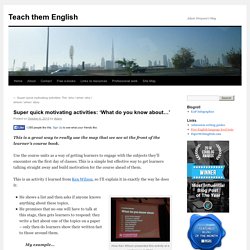
Use the course units as a way of getting learners to engage with the subjects they’ll encounter on the first day of classes. This is a simple but effective way to get learners talking straight away and build motivation for the course ahead of them. This is an activity I learned from Ken Wilson, so I’ll explain it in exactly the way he does it: How Ken Wilson presented this activity at a conference in 2013. He shows a list and then asks if anyone knows anything about these topics.He promises that no one will have to talk at this stage, then gets learners to respond: they write a fact about one of the topics on a paper – only then do learners show their written fact to those around them. My example…New Zealand: It is in the southern hemisphere This is a great way to get learners to interact with a coursebook and to have some personal input into discussing it as a whole. Re-imagining the grammar classics: Using the DO IT technique with gap fill exercises.
This is the second in a series of blog posts in which I’ll present a range of activities that can be used in class with minimal – or even no – preparation at all.
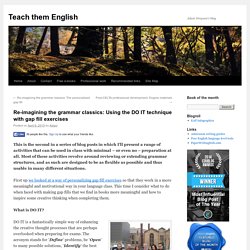
Most of these activities revolve around reviewing or extending grammar structures, and as such are designed to be as flexible as possible and thus usable in many different situations. First up we looked at a way of personalizing gap fill exercises so that they work in a more meaningful and motivational way in your language class. This time I consider what to do when faced with making gap fills that we find in books more meaningful and how to inspire some creative thinking when completing them.
What is DO IT? They like to DO IT, DO IT! Re-imagining the grammar classics: The personalized gap fill. This is the first in a series of blog posts in which I’ll present a range of activities that can be used in class with minimal – or even no – preparation at all.
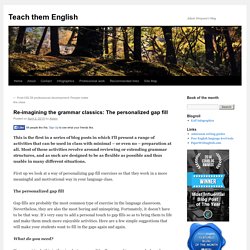
Most of these activities revolve around reviewing or extending grammar structures, and as such are designed to be as flexible as possible and thus usable in many different situations. First up we look at a way of personalizing gap fill exercises so that they work in a more meaningful and motivational way in your language class. The personalized gap fill Gap fills are probably the most common type of exercise in the language classroom. Nevertheless, they are also the most boring and uninspiring. What do you need? If you want to do this in the simplest way possible all you need is a pen and a board.
Personalizing your gap fill will have a positive effect on your class! Day 10 of my Grammarly Christmas: an activity for teaching there is/are. Day 9 of my Grammarly Christmas: fun and motivating grammar activities for beginner classes. Welcome back to my ‘12 Grammarly Days of Christmas.’

For twelve days in the month of December I’m posting either an infographic highlighting the rules that govern the ways we use a certain grammatical point, ideas to help those of us who get confused by said grammar point, and sometimes maybe even a few activities thrown in for good measure. Today is now the ninth day of my Christmas marathon which means I’m moving slowly but surely towards the end of my blogging marathon! Grammar exercises are a fundamental ingredient of many language lessons, but can become a bit of a drag for both us and our learners if we’re not careful.
However, grammar need not necessarily become a dry and tedious affair. If we can make grammar exercises as learner-focused and interactive as possible, we can keep them interesting, enjoyable and, most importantly, effective. 1. The format is simple and therefore easily recognizable to every learner… a surefire winner! Day 8 of my Grammarly Christmas: demonstrative adjectives and pronouns. A very warm welcome back to my ‘12 Grammarly Days of Christmas.’
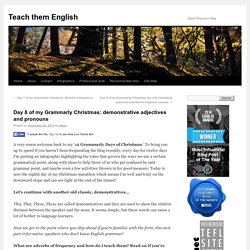
To bring you up to speed if you haven’t been frequenting the blog recently, every day for twelve days I’m posting an infographic highlighting the rules that govern the ways we use a certain grammatical point, along with ideas to help those of us who get confused by said grammar point, and maybe even a few activities thrown in for good measure. Today is now the eighth day of my Christmas marathon which means I’m well and truly on the downward slope and can see light at the end of the tunnel! Let’s continue with another old classic, demonstratives… This, That, These, Those are called demonstratives and they are used to show the relative distance between the speaker and the noun.
It seems simple, but these words can cause a lot of bother to language learners. Now we get to the point where you skip ahead if you’re familiar with the form, this next part is for native speakers who don’t know English grammar! Day 7 of my Grammarly Christmas: adverbs of frequency. A warm welcome back to my ‘12 Grammarly Days of Christmas’… Confused?
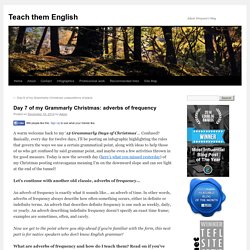
Basically, every day for twelve days, I’ll be posting an infographic highlighting the rules that govern the ways we use a certain grammatical point, along with ideas to help those of us who get confused by said grammar point, and maybe even a few activities thrown in for good measure. Today is now the seventh day (here’s what you missed yesterday) of my Christmas posting extravaganza meaning I’m on the downward slope and can see light at the end of the tunnel! Day 6 of my Grammarly Christmas: prepositions of place. Those of you who’ve dropped by recently will know that I’m embarking on ‘The 12 Grammarly Days of Christmas’.

Every day for twelve days, I’ll be posting on a well-known and well-loved grammar theme. Today is now the sixth day of my Christmas posting extravaganza; I’m officially half way there and I’m feeling steadily more confident I can do it! Let’s continue what I started on day five, with an old classic: prepositions of place… The prepositions at, in and on are often used in English to talk about places (physical positions) and times. Day 5 of my Grammarly Christmas: prepositions of time.
Those of you who dropped by yesterday will already know that I’m embarking on ‘The 12 Grammarly Days of Christmas’. Every day for twelve days, I’ll be posting an infographic highlighting the rules that govern the ways we use a certain grammatical point, along with ideas to help those of us who get confused by said grammar point, and maybe even a few activities thrown in for good measure. Today is now the fifth day of my Christmas posting extravaganza; I’m nearly half way there and I’m feeling steadily more confident I can do it!
Let’s continue with an old classic, by looking at prepositions of time… The prepositions at, in and on are often used in English to talk about places (physical positions) and times. These prepositions can be incredibly tricky for learners, because sometimes the choice of one over another in a particular phrase or sentence seems arbitrary. If we examine these different aspects of usage for the three prepositions, a general pattern emerges. Day 4 of my Grammarly Christmas: using video clips to teach grammar. Day 3 of my Grammarly Christmas: past perfect and past perfect continuous. Day 2 of my Grammarly Christmas: for and since with present perfect. Those of you who dropped by yesterday will already know that I’m in a sharing mood because it’s Christmas!
As crazy as I might be for trying it, I’m embarking on ‘The 12 Grammarly Days of Christmas’. Every day for the next twelve days, I’ll be posting an infographic highlighting the rules that govern the ways we use a certain grammatical point, along with ideas to help those of us who get confused by said grammar point, and maybe even a few activities thrown in for good measure. Today is only the second day of my Christmas posting extravaganza, but I’m already feeling confident I can do it! Let’s continue in classic style, by looking at the differences between the uses of for and since with the present perfect simple tense… On the face of it, the way we use ‘for’ and ‘since’ with the present perfect is really straightforward.
Now we get to the point where you skip ahead if you’re familiar with the form, this next part is for native speakers who don’t know English grammar! Day 1 of my Grammarly Christmas: present perfect continuous.